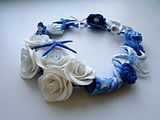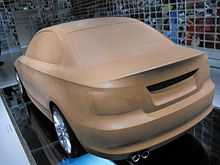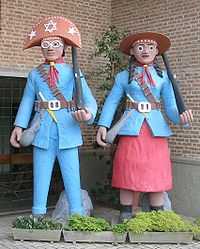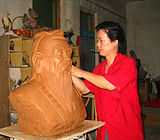Modelling clay



Modelling clay is any of a group of malleable substances used in building and sculpting. The material compositions and production processes vary considerably.[1]
Ceramic clay
Ceramic clays are water-based substances made from clay minerals mixed with other raw materials. They are baked at high temperatures, in a process known as firing to create ceramics, such as terra cotta, earthenware, stoneware, and porcelain. Paper clay produced by pottery clay manufacturers is any of these clay bodies, to which a small percentage of processed cellulose fiber has been added. When kiln fired, the paper burns out, leaving the clay body. Consequently the firing temperatures and glazes selection should be the same on those used with the clay body.
Oil-based clay
Oil-based clays are made from various combinations of oils, waxes, and clay minerals. Because the oils do not evaporate as does water, oil-based clays remain malleable even when left for long periods in dry environments. Articles made from oil-based clays cannot be fired, and therefore are not ceramics. Because the viscosity of oils decreases as temperature rises, the malleability is influenced by heating or cooling the clay. Oil-based clay is not soluble in water. It can be re-used and so is a popular material for animation artists who need to bend and move their models. It is available in a multitude of colours and is non-toxic.
Oil-based clays are referred to by a number of genericized trademarks. Plastilin, was patented in Germany by Franz Kolb in 1880. Plasteline was developed by Claude Chavant in 1892, and trademarked in 1927.[2] Plasticine was invented in 1897 by William Harbutt of Bathampton, England. Plastilina is trademarked as Roma Plastilina by Sculpture House, Inc. According to their website, their formula is 100 years old.[3] Roma Plastilina contains sulfur, and since certain moldmaking compounds will not set in sulfur's presence, this brings difficulty to making molds of items made of Industrial plasticine. In India, oil based "No Sulphur" clay is manufactured by Uday Industries for industrial as well as retail use.
Being readily worked in fine detail, oil-based clays are also suitable for the creation of detailed sculptures from which a mold can be made. Castings and reproductions in a much more durable material can then be produced. Cars and airplanes may be created using industrial design-grade modeling clay.
Polymer clay
Polymer clay is a modeling material that cures when heated from 265 °F (129 °C) to 275 °F (135 °C) for 15 minutes per 1⁄4 inch (6.4 mm) of thickness, and does not significantly shrink or change shape during the process. Despite being called "clay", it generally contains no clay minerals. Polymer clay is sold in craft, hobby and art stores, and is used by artists, hobbyists, and children. Polymer clay is also popular in animation since it allows static forms to be manipulated frame after frame. Leading brands of polymer clay include Fimo, Kato Polyclay, Sculpey, & Modello.
Paper clay
Paper clay is hand made or commercially available clay to which a small percentage of processed cellulose fibre is added. The fibre increases the tensile strength of the dry clay and enables dry-to-dry and wet-to-dry joins. Commercial paper clays air-dry to a firm, lightweight sculpture, with minimal shrinking during the drying process.[4]
Paper clay can be used as an unfired body in craft and doll making. It is used in ceramic art studios as sculptural and functional studio pottery.
See also
- Papier-mâché (papier-mâché), construction material made of paper and a wet paste.
- Salt dough, used for modelling, such as Play-Doh and Kanten Clay Studio.
- Clay (industrial plasticine)
- Plasticine
- Paper clay
References
- ↑ Putman, Brenda, ‘’The Sculptor’s Way: A Guide to Modelling and Sculpture’’, Farrar & Rinehart, Inc, New York, 1939 p.8
- ↑ http://www.sculpturetools.com/chavant/cart/plasteline.html
- ↑ http://www.sculpturehouse.com/about_us.aspx
- ↑ ""A Paperclay Update" by Graham Hay". Ceramics Technical. 2006. Retrieved 2007-12-14. Article hosted by grahamhay.com.au
- Hay, G. (2006) "A Paperclay Update", Ceramics Technical, 22, 39-40
- CLAYCRAFT by DECO clay for making flowers
| Wikimedia Commons has media related to Clay (sculpture). |

